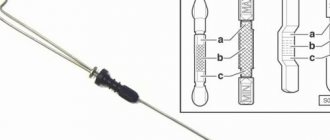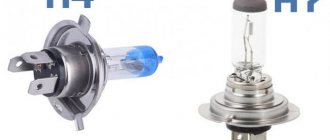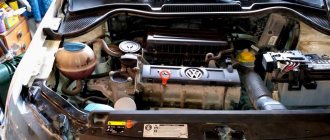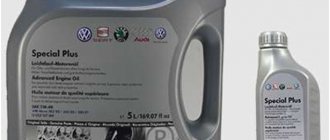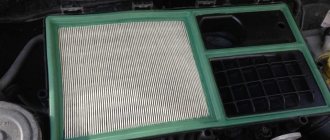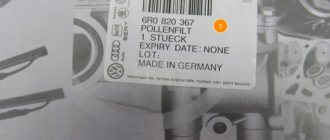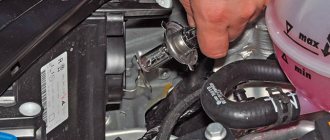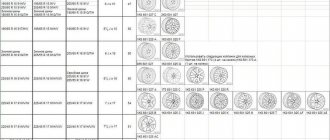Description of the CFNA engine
The CFNA engine is installed on several car models, including the Volkswagen Polo Sedan
The CFNA engine is a four-cylinder power plant equipped with 16 valves. The power supply system is implemented using distributed injection. One of the features of the engine is a DOHC type gas distribution mechanism - 2 camshafts are installed in the cylinder head.
When developing this internal combustion engine, Volkswagen did not plan to introduce unique advanced elements, so the engine turned out to be ordinary, although some features stand out:
- All elements of the GRS mechanism are securely hidden under plastic covers, and bright paint is applied to important components;
- The BC is made of aluminum alloy, which significantly reduces the weight of the block and increases heat transfer. The main channels of the oil system found their place here;
- The sleeves are thin-walled, made of durable material;
- The cylinder head is of a one-piece design, made like the cylinder head - from aluminum.
The CFNA lubrication system is of a universal type, only important components are processed under pressure, the remaining parts are treated by spraying. Lubricant is pumped through a pump installed in the crankcase. It rotates via the crankshaft.
The injection system is of a distributed type. Due to the harmonious functioning of the injectors and throttle assembly, the supply of fuel assemblies is balanced. In a particular case, the throttle is responsible for the flow of air into the engine cylinders under a strict dosage. When the damper is open, air masses are drawn in, a flammable mixture is formed, which then goes to the BC. The fuel supply system is directly controlled by electronics, receiving signals from sensors and a controller.
How to choose an analogue
The choice of oil substitute for Volkswagen Polo is carried out in accordance with the requirements of the plant.
VAG Specifications
For car models produced before 2001, the concern recommends using VW 500.00 mixtures. Due to the obsolescence of the standard, it is permissible to use more recent certificates or a group of oils that comply with ACEA A1/B1. The factory approval supports naturally aspirated engines without exhaust treatment systems.
Polo cars produced after this period (2010-2015 and later) need to pour such mixtures.
- 501.01 – support for power plants with direct fuel injection, regardless of the fuel consumed.
- 502.00 is a toughened version of the first standard. ACEA A3/B3 compliance available.
- 503.00 – used where lightweight turbines are installed and there are no particulate filters. Improved compatibility with extended service intervals.
- 504.00 - the standard is relevant for all power plants with exhaust cleaning systems, turbocharging or direct injection. The service life of one portion is 30,000 km.
The basis
The Volkswagen Polo uses all three types of lubricants available in 2022.
Mineralka
Operation is relevant for Volkswagen Polo cars manufactured before 2000. The lubricant is produced by refining sour crude oil. It is characterized by minimal protective properties and a moderate service life. The advantage is the affordable cost.
CFNA Service Schedule
Volkswagen guarantees trouble-free operation of the engine for 200 thousand km only if it is properly and timely serviced. Basic routine procedures must be carried out every 15 thousand kilometers (for example, changing the oil or filter) if the engine is operated under normal, standard conditions. Otherwise, the engine maintenance period must be reduced.
Let's take a closer look at the specific procedures and their timing:
- It is advisable to update the oil every 10-15 thousand kilometers by filling with 5W-40 or other compounds that meet the VW-Norm 502 approval;
- in the same period of time, simultaneously with changing the oil, it is necessary to install a new oil filter to replace the old one;
- after 10-15 thousand kilometers, check the condition of the plug on the crankcase;
- every 15 thousand kilometers you need to check the level and condition of the refrigerant - if the volume decreases, add antifreeze;
- change the air and fuel filters at least every 30 thousand km - in conditions of very dusty roads, update the air filter after 8 thousand km.
Don't know what oil to put in your CFNA engine? A composition with a 5W40 tolerance is quite suitable
Once a year, it is advisable to flush the engine with appropriate products. This is done when changing the oil, when the system is free of lubrication.
When to check the oil condition
Many people check the condition of the oil according to regulations. In fact, it is better to do this earlier, without waiting for the regulations. The following signs indicate problems with oil:
- Insufficient engine power
- Increased fuel consumption
- Increased oil consumption
- Possible delays and jerks when changing gears
- Excessive noise and vibration levels
If these deviations are detected, it would be a good idea to check the condition of the oil.
CFNA Fault Overview
The manufacturer insists - regularly monitor the amount of lubricant, and the engine will not cause serious problems during operation! In addition, when driving in the summer with a half-empty tank, the fuel pump is under heavy load. It may fail unexpectedly. Signs of a dying fuel pump: A strong, buzzing sound. Replacing the pump filter element can only temporarily correct this problem. In the future, only replacement will help.
The main malfunction of the presented power unit is associated with knocking or diesel noise - a familiar problem to almost all owners of the Polo Sedan. The engine literally rumbles, especially when cold. The reason lies in the special shape of the CFNA pistons and the outdated design of the exhaust manifold. There are two ways to fix this problem:
- complete replacement of pistons and VK with simultaneous reprogramming of the ECU;
- installing ET pistons instead of standard ones.
The CFNA engine pistons have a special shape. In addition, they are coated with a special protective layer
The first option will not only eliminate the knocking problem, but will also make it possible to modernize the engine. The second method is more suitable for new motors that are still under warranty. You can order such work from a dealer if the noise level is really annoying.
CFNA knocks also occur when driving on uneven road surfaces. As a rule, this is due to a weakening of the engine mount - most often the left mount. It cannot withstand loads and quickly collapses.
Another malfunction, again related to the exhaust manifold. Over time, cracks appear on it. Signs of a broken VC will be the changed sounds of the internal combustion engine during operation. As in the first case, the problem can be completely solved by replacing the standard collector with a more modern “spider” type. If you don’t want to change the intake, you can try welding the block using argon welding.
In addition to oil, it is also recommended to fill in high-quality fuel - gasoline for CFNA must have an octane rating of at least AI-95! This will be a guarantee against instability of speed, jerks and jolts. In addition, the piston group of this engine is coated with graphite. This protective layer wears off quickly when using low-grade gasoline. Scores appear on the inner walls of the cylinders. You should also not allow the engine to overheat frequently, realizing that a lack of oil will immediately lead to the destruction of the connecting rod bearings.
Types of motor oils
At the end of the article, we will look at what types of motor oils there are. There are only three of them.
- Synthetic is the best motor oil today. It has good fluidity properties, and also has excellent non-stick and antioxidant properties, and is not afraid of frost and sudden temperature changes. Recommended for modern cars with low mileage. The main disadvantage of oil is its high cost due to the listed advantages.
- Mineral is the cheapest motor oil; it is often used as a technical fluid for flushing the engine from old oil residues, metal shavings and other deposits. It should not be poured into the Volkswagen Polo engine, especially with low mileage. In addition, mineral water should not be used at low temperatures. The fact is that this is a thicker oil that is prone to solidification.
- Semi-synthetic is a worthy option to replace mineral oil. It has optimal advantages for its price. It moderately resists low temperatures and has a longer lifespan than the mineral composition. And yet, semi-synthetics cannot completely replace pure synthetics, and they should be used only in extreme cases.
- We can conclude that the first place for Volkswagen is any synthetic oil - either original or a well-known analogue. It is better to use semi-synthetics for high mileage, and it is not recommended to fill in mineral oil.
CFNA tuning options
This engine has potential. Initially, there is a certain reserve of power that can be intelligently deployed. As mentioned above, the pistons and exhaust manifold of this unit are outdated. It is advisable to replace or remake them:
- VC needs to use a 4-2-1 or 4-1 bescatless;
- Install a modern cold air intake system;
- Reflash the ECU.
This will increase the power of the unit to 130 horses, without significantly reducing the resource.
The Spider 4-1 rollless exhaust manifold will increase engine power several times
List of CFNA modifications
Today on the markets you can find two main modifications of the unit:
- CFNA, developing 105 hp. With.;
- CFNB developing 85 HP. With.
Official firmware for CFNB engine ECU
The CFNA accelerates to 100 km/h in 10.5 seconds, the CFNB modification is less fast - in 11.9 seconds. Torque 153 Nm versus 145 Nm. The differences between the versions are also evident in their design - the more powerful modification is equipped with a stepless system for changing the phases of the gas distribution system. The advantage of CFNB over CFNA is that there is less demand for fuel quality - you can safely pour AI-92.
If previously all engines were assembled exclusively in Germany, today this is also done here in Russia. True, at the Kaluga plant the engines are equipped with a timing belt drive, when before they were with a chain.
Vw polo sedan 1.6 110 hp (cwva)
We begin the draining procedure:
- Raise the hood, then find the filler neck on the engine and unscrew the plug (Fig. 6). Fig.6 Oil filler neck
- Now we go down under the car and place a waste container in the drainage area. You can use a cut canister or an old bucket.
- We unscrew the drain plug with a wrench or a 18 or 19 socket, depending on its type (Fig. 7). Fig.7 Drain plug
- Now you need to remove the old oil filter. This can be done from above, from the engine compartment (Fig. 8). Fig.8 Oil filter on top
- The filter is clearly visible from above, but unscrewing it is not so convenient, so we do it from below. Access is very good, nothing interferes (Fig. 9). Fig.9 Oil filter from below
- On this engine the drain plug is also located, not at the lowest point. Therefore, you can use a syringe with a tube. To pump out the remaining waste, as shown in Figure 5.
To unscrew the filter element, it is advisable to have a special puller. If it is not available, you can try to unscrew the filter using improvised means. In this case, you can use, for example, an old alternator belt, a regular belt, a bicycle chain or a simple screwdriver.
Unscrewing the oil filter using improvised means
Using this method, you can drain the maximum amount of used oil, after which you can proceed to further actions. The main thing is not to forget, everything that we unscrewed must be put back in place.

